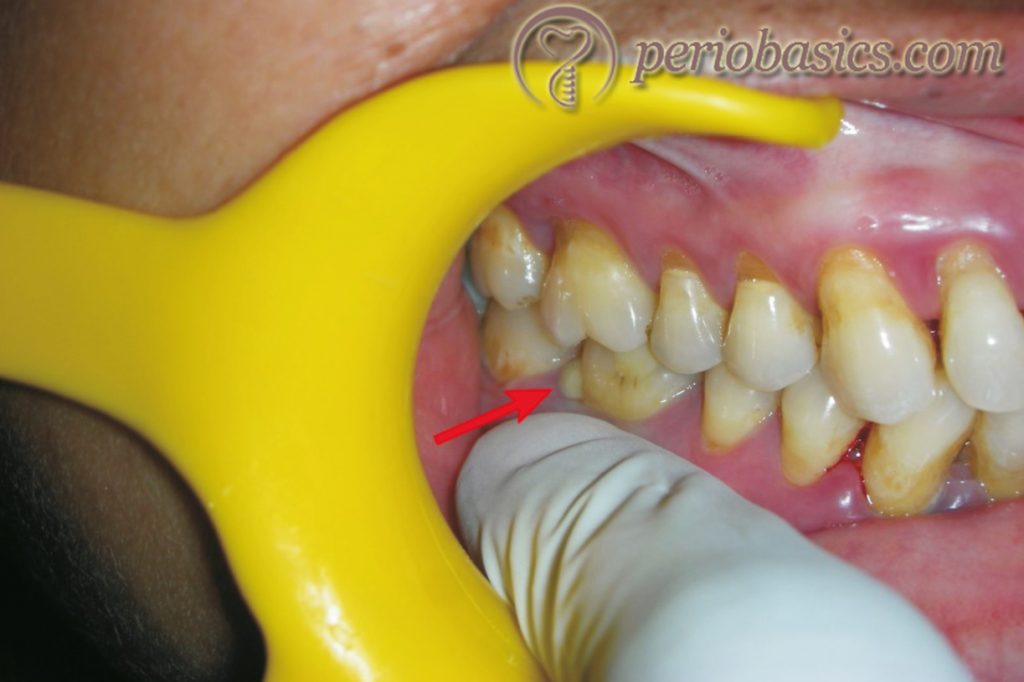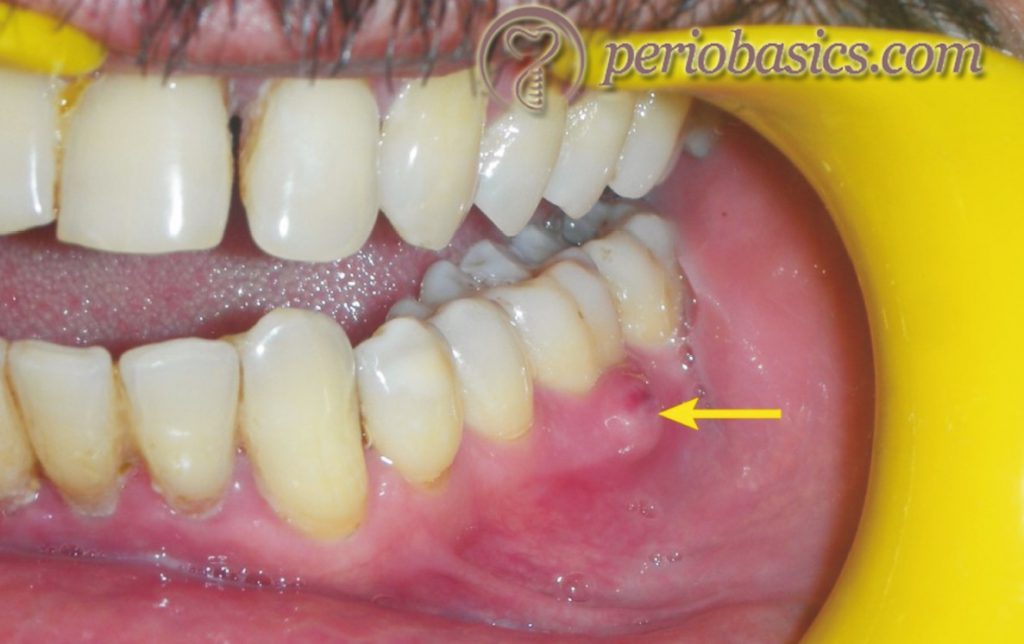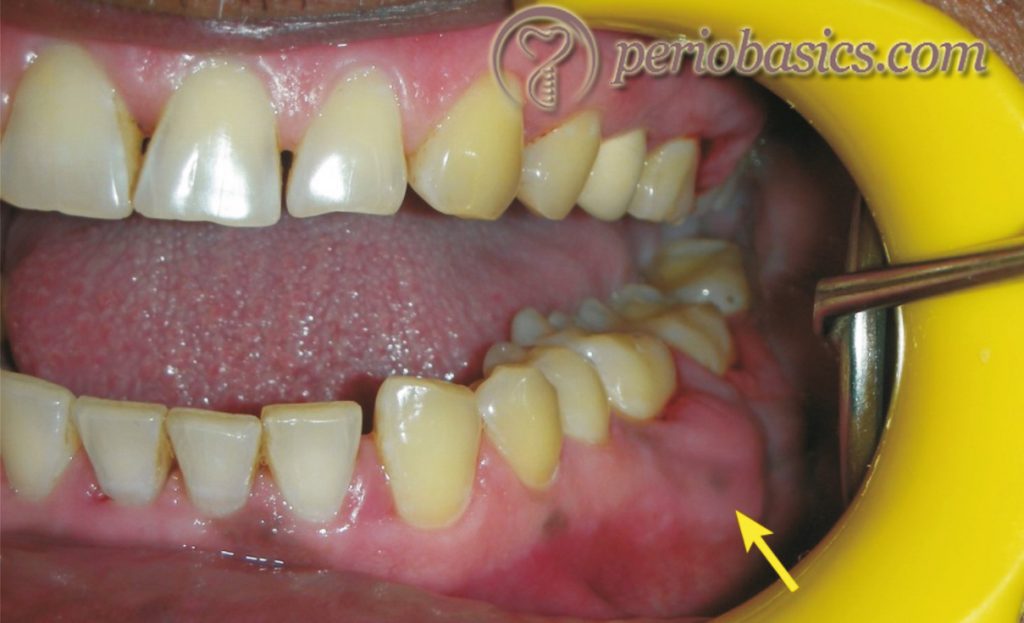Introduction to periodontal abscess
Periodontal abscess is a localized acute bacterial infection confined to the tissues of the periodontium and not arising from the tooth pulp. It is an acute destructive process in the periodontium resulting in localized collections of pus, communicating with the oral cavity through the gingival sulcus or other periodontal sites. It is the third most frequent dental emergency, representing 7-14% of all dental emergencies and affecting 6-7% of all patients 1. It is formed as a result of rapidly growing bacteria within a periodontal pocket, resulting in abscess formation. It is a frequent periodontal condition in which periodontal tissues may be rapidly destroyed. Periodontal abscesses may result in complications, due to bacteremia, that may cause infection in distant locations 2-3.
Clinical features of periodontal abscess
Periodontal abscess may be acute or chronic in its onset. An acute exacerbation in chronic cases can be seen in some cases. The clinical features of periodontal abscess include,
- The patient complains of pain, which is throbbing in an acute periodontal abscess and dull and gnawing in a chronic periodontal abscess.
- Edema and redness at the affected site.
- The involved tooth is sensitive to lateral percussion.
- Increased mobility of the involved tooth.
- Increased probing depth. Bleeding or purulent exudates on probing.
- Suppuration can be spontaneous or may be present on putting lateral pressure on the involved surface of gingiva.
- Draining sinus may be present.
- In chronic cases, bone loss can be seen in the radiographic examination.
- In delayed cases of periodontal abscess, the patient may have lymph node enlargement, fever, and malaise.

Diagnosis
Diagnosis of the periodontal abscess is made depending on the chief complaint of the patient, medical/dental history of the patient and clinical and radiographic examination. Development of periodontal abscess is usually associated with pre-existing periodontitis. Drainage of the abscess may be spontaneous with slight provocation. It is important to note that periodontal abscesses do not always drain from the same surface of the root where the periodontal pocket is present. Further, radiographic examination and status of the pulp provide important information regarding swelling. Radiograph taken ……….. Contents available in the book …… Contents available in the book…… Contents available in the book…… Contents available in the book…….
Periobasics: A Textbook of Periodontics and Implantology
The book is usually delivered within one week anywhere in India and within three weeks anywhere throughout the world.
India Users:
International Users:
Classifications of periodontal abscess
Classification according to the anatomical location:
Gingival abscess: In this case, abscess involves the marginal gingiva or the interdental papilla.
Lateral periodontal abscesses/ parietal abscesses: In this case, abscess is present adjacent to the periodontal pocket that may lead to the destruction of periodontal ligaments and alveolar bone.
Combined periodontal/ endodontic abscesses: In this case, the localized, circumscribed abscess which either originates from dental pulp or the periodontal tissues surrounds the root apex and/or the apical periodontium of the involved tooth.
Pericoronal abscesses: This is localized purulent infection within the tissue surrounding the crown of a partially erupted tooth.
Classification according to the duration of the disease:
Acute periodontal abscess:
When the abscess develops during a short period of time, within days or a week, it is called as an acute periodontal abscess. There is sudden onset of pain on biting and a deep throbbing pain in the involved tooth. The gingiva appears red, swollen and tender 5-6. In the early stages, there is no fluctuation or pus discharge, but as the disease progresses, the pus and discharge from the gingival crevice become evident. Lymph node enlargement may be evident as the duration of infection prolongs.

Chronic periodontal abscess:
In this case, the infection is of prolonged duration and the abscess develops slowly. Because of prolonged duration, the involved tooth may become mobile and tender. Pus may be present and discharges from the gingival crevice or from a sinus in the mucosa overlying the affected root. Pain is usually of low intensity as compared to acute periodontal abscess.

Classification according to the etiology:
Periodontitis related abscess: When acute infection originates from the microbial biofilm in deepened periodontal pocket.
Non-Periodontitis related abscess: When the acute infection originates from another local source e.g., foreign body impaction, alteration in the root integrity.
Etiology of periodontal abscess
The periodontal abscess usually develops in an association with moderate to deep periodontal pockets 7-8. Other etiological factors include incomplete calculus removal, embedding ……….. Contents available in the book …… Contents available in the book…… Contents available in the book…… Contents available in the book…….
Periodontitis related abscess:
- Deep and tortuous periodontal pockets 1.
- Marginal closure of a periodontal pocket that may lead to an extension of the infection into the surrounding periodontal tissues due to the pressure of the suppuration inside the closed pocket 9-11.
- The changes in the composition of the microflora, bacterial virulence, or in host defenses could also make the pocket lumen inefficient to drain the increased suppuration 12.
- Treatment with systemic antibiotics without subgingival debridement in patients with advanced periodontitis may also cause abscess formation 13-15.
Non-periodontitis related abscess:
- Due to impaction of foreign bodies such as a piece of dental floss, a popcorn kernel, a piece of a toothpick, fishbone, or an unknown object 16-18.
Perforation of the tooth wall by endodontic instrument 1,19. - Due to infected lateral cysts 12.
- Anatomical factors affecting the root morphology like the presence of cervical cemental tears may also predispose to periodontal abscess formation 10, 20, 21.
| Differences between gingival and periodontal abscess | |
|---|---|
| Gingival abscess | Periodontal abscess |
| Limited to marginal gingiva and interdental papilla. | Usually, involves attached gingiva. |
| Caused by bacteria being carried deep into the tissues when a foreign substance like a toothbrush bristles is forcefully embedded in the gingiva. | Caused because of the localization of inflammation due to one of the underlying reasons: 1. Extension of infection to lateral wall of pocket. 2. Extension of infection deep into the supporting periodontal tissues. 3. In the deep end of a spiral or complex pocket. 4. Incomplete removal of calculus leads to the shrinkage of the gingival wall and occludes the opening of the pocket. 5. Due to perforation through the root during endodontic therapy. |
Microbiology of periodontal abscess
Periodontal abscess microbiota is usually indistinguishable from the microflora found in the subgingival plaque in chronic periodontitis 11. It has been reported that around 60% of cultured bacteria from periodontal abscess are strict anaerobes, especially Gram-negative anaerobic rods and Gram-positive facultative cocci 11. It has been demonstrated that Fusobacterium spp., P. intermedia/nigrescens, and P. gingivalis are the most prevalent microorganisms associated with periodontal abscesses 11,15,22. Other microorganisms found in periodontal abscess include T. forsythia 23, A. actinomycetemcomitans 24, 25, Micromonas micros 25, Campylobacter rectus 23, Prevotella melaninogenica 11. One study has proposed the presence of enteric and non-fermenter Gram-negative rods in periodontal abscess, which according to the authors have a potential role in the rapid tissue destruction observed in periodontal abscesses 25. Studies have demonstrated that bacterial species with a capacity of producing proteinases, such as P. intermedia may increase the availability of nutrients and, thereby, facilitating an increase in the number of bacteria inside the abscess 26-27.
| Differences between periodontal and periapical abscess | |
|---|---|
| Periodontal abscess | Periapical abscess |
| Periodontal pocket is present. | Caries/fracture is present. |
| May occur after periodontal treatment. | May occur after endodontic or restorative treatment. |
| Tooth is vital. | Tooth is non-vital. |
| Pain is usually dull and localized (easy to localize due to the presence of tactile fibers in the periodontal ligament). | Pain is severe and difficult to localize (difficult to localize, as pulp basically consists of only pain perceiving fibers) |
| Swelling is present on the lateral surface of root usually without fistulous track as abscess usually drains from pocket opening. | Swelling is present at the apical portion of the tooth, which drains by the formation of a fistulous track. |
| Involved tooth is tender on lateral percussion. | Involved tooth is tender on vertical percussion. |
| Usually not visible on the radiograph. | Appears as a periapical radiolucency. |
| Responds to periodontal treatment. | Does not respond to periodontal treatment. |
Recommended treatment for periodontal abscess
Treatment of periodontal abscess is done in two steps,
- First and foremost is the management of the acute lesion.
- Later on, appropriate treatment of the original and/or residual lesion is done once the acute situation has been controlled.
Drainage of abscess through pocket is usually the first treatment that is given to the patient. It is followed by scaling of the tooth surface, compression and debridement of the soft tissue wall and irrigation with antibiotic solutions. If a foreign body is present in the pocket, it should be removed. Oral hygiene instructions are given to the patient. Systemic antibiotic and anti-inflammatory treatment is started and the patient is recalled for re-assessment within 24-48 hours. Systemic antibiotic treatment for the dental abscess prevents any bacterial spread and serious complications 27-29.
Usually, the abscess is drained through pocket retraction. However, if the lesion is sufficiently large, pinpointed and fluctuating, an external incision can be made to drain the abscess. Local anesthesia (nerve block is preferred) is applied in the involved area. Swelling is isolated with a gauge piece. A vertical incision is made through the most fluctuant center of the abscess with a #15 or # 11 surgical blade. Lateral pressure is applied with a gauge piece to clear out the abscess present in the area. With the help of a periosteal elevator or curette, the tissue which is lateral to the incision is separated. If the incision is large, sutures may be placed to secure the margins 30, 31. Post-operatively, the patient is advised to do warm saline rinses from the next day. Chlorhexidine mouthwash can also be advised. As stated above, systemic antibiotic and anti-inflammatory treatment is started. Gingiva returns to normal within 6 to 8 weeks.
In some cases, however, where the vertical bone loss and deep pockets are present, gingivectomy or periodontal flap procedures are recommended 9. Surgical flaps have also been ……….. Contents available in the book …… Contents available in the book…… Contents available in the book…… Contents available in the book…….
Recommended antibiotic treatment:
Culture sensitivity testing of microorganisms involved in periodontal abscess before starting antimicrobial therapy is not feasible in many cases because it is an acute condition requiring immediate treatment and also obtaining a clean bacterial sample for culture is difficult. Following antibiotics are recommended for empirical use 1, 32,
- Phenoxymethyl penicillin 250-500 mg, 6 hourly for 7-10 days.
- Amoxycillin/ Augmentin 250-500 mg 8 hourly for 7-10 days.
- Metronidazole 250 mg, 8 hourly for 7-10 days (Can be combined with amoxicillin. The use of metronidazole is contraindicated in pregnant patients/ consumption of alcohol).
- Tetracycline HCl 250 mg, 6 hourly for 7-14 days.
- Doxycycline 100 mg, twice daily for 7-14 days (the use of tetracycline is contraindicated in pregnant patients and in children under 10 years of age.).
Conclusion
Periodontal abscess is a relatively common condition in patients with moderate to deep pockets. The patient usually presents with pain and discomfort. Periodontal abscess needs to be differentiated from periapical and gingival abscesses. Also, conditions like poorly controlled diabetes may lead to multiple abscesses for which the underlying cause needs to be treated. No specific microorganisms have been found to be particularly associated with periodontal abscess; instead, the microbial composition in periodontal abscess has been found to be close to microorganisms found in deep periodontal pockets. Drainage of abscess and removal of the etiological agent is required for the healing of involved tooth-supporting structures.
References
References are available in the hard-copy of the website.
Periobasics: A Textbook of Periodontics and Implantology
The book is usually delivered within one week anywhere in India and within three weeks anywhere throughout the world.

